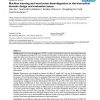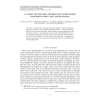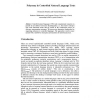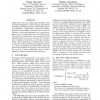BMCBI
2006
13 years 11 months ago
2006
Background: Word sense disambiguation (WSD) is critical in the biomedical domain for improving the precision of natural language processing (NLP), text mining, and information ret...
CORR
2008
Springer
13 years 11 months ago
2008
Springer
Abstract. A large class of unsupervised algorithms for Word Sense Disambiguation (WSD) is that of dictionary-based methods. Various algorithms have as the root Lesk's algorith...
BMCBI
2010
13 years 11 months ago
2010
Background: Word sense disambiguation (WSD) algorithms attempt to select the proper sense of ambiguous terms in text. Resources like the UMLS provide a reference thesaurus to be u...
GIR
2008
ACM
14 years 15 days ago
2008
ACM
Toponym Disambiguation, i.e. the task of assigning to place name their correct reference in the world, is getting more attention from many researchers. Many methods have been prop...
CNL
2009
14 years 16 days ago
2009
Controlled natural languages (CNL) and computational semantics in general do not address word sense disambiguation, i.e., they tend to interpret only some functional words that are...
CLEF
2009
Springer
14 years 16 days ago
2009
Springer
Abstract. The Robust-WSD at CLEF 2009 aims at exploring the contribution of Word Sense Disambiguation to monolingual and multilingual Information Retrieval. The organizers of the t...
COLING
1990
14 years 18 days ago
1990
In this paper, we describe a means for automatically building very large neural networks (VLNNs) from definition texts in machine-readable dictionaries, and demonstrate the use of...
ACL
1996
14 years 23 days ago
1996
In this paper, we present a new approach for word sense disambiguation (WSD) using an exemplar-based learning algorithm. This approach integrates a diverse set of knowledge source...
ACL
1996
14 years 23 days ago
1996
This paper presents a method for word sense disambiguation and coherence understanding of prepositional relations. The method relies on information provided by
COLING
2000
14 years 24 days ago
2000
Multi-word terms are traditionally identified using statistical techniques or, more recently, using hybrid techniques combining statistics with shallow linguistic information. Al)...




